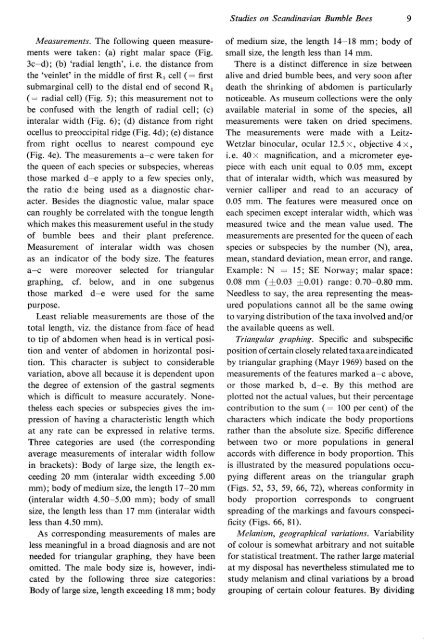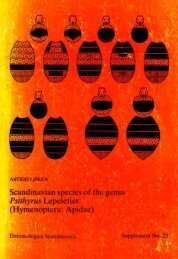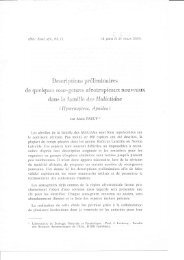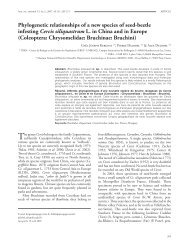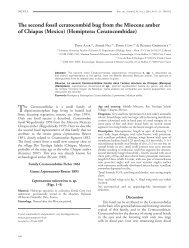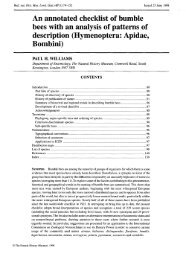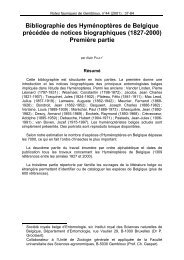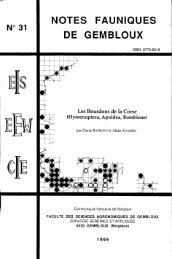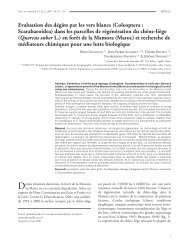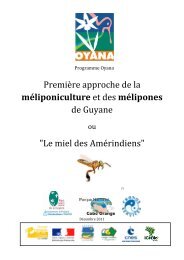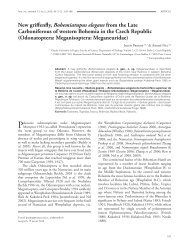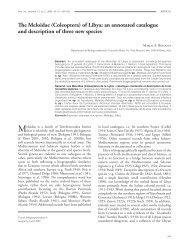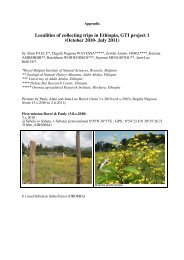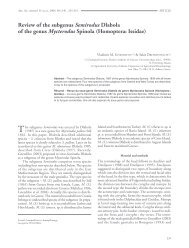Bumble Bees
Bumble Bees
Bumble Bees
Create successful ePaper yourself
Turn your PDF publications into a flip-book with our unique Google optimized e-Paper software.
Studies on Scandinavian <strong>Bumble</strong> <strong>Bees</strong>Measurements. The following queen measurementswere taken: (a) right malar space (Fig.3c-d); (b) 'radial length', i.e. the distance fromthe 'veinlet' in the middle of first Rr cell (: firstsubmarginal cell) to the distal end of second Rr( - radial cell) (Fig. 5); this measurement not tobe confused with the length of radial cell; (c)interalar width (Fig. 6); (d) distance from rightocellus to preoccipital ridge (Fig. 4d); (e) distancefrom right ocellus to nearest compound eye(Fig. 4e). The measurements a-c were taken forthe queen of each species or subspecies, whereasthose marked d-e apply to a few species only,the ratio d:e being used as a diagnostic character.Besides the diagnostic value, malar spacecan roughly be correlated with the tongue lengthwhich makes this measurement useful in the studyof bumble bees and their plant preference.Measurement of interalar widthwas chosenas an indicator of the body size. The featuresa-c were moreover selected for triangulargraphing, cf. below, and in one subgenusthose marked d-e were used for the samepurpose.Least reliable measurements are those of thetotal length, viz. the distance from face of headto tip of abrJomen when head is in vertical positionand venter of abdomen in horizontal position.This character is subject to considerablevariation, above all because it is dependent uponthe degree of extension of the gastral segmentswhich is difficult to measure accurately. Nonethelesseach species or subspecies gives the impressionof having a characteristic length whichat any rate can be expressed in relative terms.Three categories are used (the correspondingaverage measurements of interalar width followin brackets): Body of large size, the length exceeding20 mm (interalar width exceeding 5.00mm) ; body of medium size, the length 17 -20 mm(interalar width 4.50-5.00 mm); body of smallsize, the length less than 17 mm (interalar widthless than 4.50 mm).As corresponding measurements of males ateless meaningful in a broad diagnosis and are notneeded for triangular graphing, they have beenomitted. The male body size is, however, indicatedby the following three size categories:Body of large size, length exceeding 18 mm; bodyof medium size, the length 14-18 mm; body ofsmall size, the length less than 14 mm.There is a distinct difference in size betweenalive and dried bumble bees, and very soon afterdeath the shrinking of abdomen is particularlynoticeable. As museum collections were the onlyavailable material in some of the species, allmeasurements were taken on dried specimens"The measurements were made witha Leitz-Wetzlar binocular, ocular 12.5 x , objective 4 x ,i. e. 40 x magnification, and a micrometer eyepiecewith each unit equal to 0.05 ffiffi, exceptthat of interalar width, which was measured byvernier calliper and read to an accuracy of0.05 mm. The features were measured once oneach specimen except interalar width, which wasmeasured twice and the mean value used. Themeasurements are presented for the queen of eachspecies or subspecies by the number (N), area,mean, standard deviation, mean error, and range.Example: N - 15 ; SE Norway; malar space:0.08 mm (+O.O: +0.01) range: 0.70-0.80 mm.Needless to s&y, the area representing the measuredpopulations cannot all be the same owingto varying distribution of the taxa involved and/orthe available queens as well.Triangular graphing. Specific and subspecificposition of certain closely related taxaare indicatedby triangular graphing (Mayr 1969) based on themeasurements of the features marked a-c above,or those marked b, d-e. tsy this method areplotted not the actual values, but their percentagecontribr"rtion to the Sum ( - 100 per cent) of thecharacters which indicate the body proportionsrather than the absolute size. Specific differencebetween two or more populations in generalaccords with difference in body proportion. Thisis illustrated by the measured populations occupyingdifferent areas on the triangular graph(Figs. 52, 53, 59, 66,72), whereas conformity inbody proportion corresponds to congruentspreading of the markings and favours conspecificity(Figs. 66, 81).Melanism, geographical variations. Variabilityof colour is somewhat arbitrary and not suitablefor statistical treatment. The rather large materialat my disposal has nevertheless stimulated me tostudy melanism and clinal variations by a broadgrouping of certain colour features. By dividing


